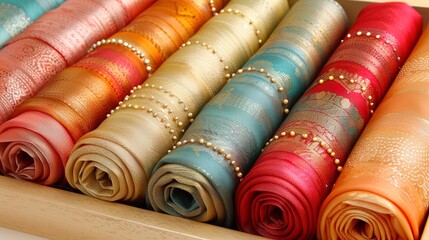Evolution of Handloom Saree Weaving Techniques Over the Centuries
Discover the evolution of handloom saree weaving techniques from ancient traditions to modern innovations at Balaram Saha Handloom Sarees. Explore the cultural significance and global appeal of Indian sarees, symbolizing timeless elegance and artisan craftsmanship.

The art of handloom saree weaving in India spans millennia, encompassing a rich tapestry of techniques, traditions, and cultural influences. From ancient times to the present day, this craft has evolved significantly, blending historical craftsmanship with modern innovations. Explore the fascinating journey of handloom saree weaving, enriched by the contributions of artisans like those at Balaram Saha Handloom Sarees, who continue to uphold this legacy of excellence.
Ancient Origins: Traditional Techniques and Cultural Significance
Handloom sarees have been woven in India since ancient times, utilizing traditional techniques that are deeply rooted in regional cultures:
- Pit Looms and Hand Spinning: Early sarees were woven on pit looms, where skilled weavers operated manually, often using hand-spun yarn made from natural fibers like cotton, silk, and wool.
- Cultural Significance: Sarees were not just garments but symbols of cultural identity, with each region developing its unique weaving styles and motifs, such as the intricate Jamdani of West Bengal or the opulent Banarasi sarees of Uttar Pradesh.
Medieval Advancements: Intricate Designs and Trade Influences
During medieval times, advancements in technology and trade routes brought significant developments to handloom saree weaving:
- Jacquard Looms: The introduction of jacquard looms revolutionized saree weaving by enabling the creation of intricate patterns and designs with precision, influencing the evolution of regional textile traditions.
- Global Trade: The advent of global trade routes during this period facilitated the export of Indian handloom sarees to distant lands, where they gained recognition for their craftsmanship and artistic appeal.
Colonial Era: Industrialization and Challenges
The colonial era marked a period of both industrialization and challenges for handloom saree weaving:
- Impact of Industrialization: The introduction of power looms during the British colonial rule increased production capacity but posed a threat to traditional handloom weavers, leading to efforts to preserve indigenous weaving techniques.
- Revival Movements: Revival movements emerged in response to the decline of handloom traditions, advocating for the preservation of artisanal skills and the promotion of handcrafted sarees.
Modern Era: Sustainability and Technological Integration
In recent decades, the handloom saree industry has witnessed a resurgence, blending tradition with modern innovations:
- Technological Integration: Advancements in technology have facilitated the integration of modern tools and techniques into traditional handloom weaving processes, enhancing efficiency while preserving craftsmanship.
Sustainability Initiatives: There is a growing emphasis on sustainable practices, including the use of organic dyes, fair trade principles, and support for artisan communities like those at Balaram Saha Handloom Sarees, who uphold ethical standards in their production processes.

Future Directions: Innovation and Global Recognition
Looking ahead, the future of handloom saree weaving appears promising with a focus on innovation and global recognition:
- Innovation in Design: Designers are increasingly experimenting with contemporary motifs and color palettes, catering to evolving consumer preferences while maintaining the authenticity of handloom sarees.
- Global Appeal: Indian handloom sarees continue to capture the imagination of fashion enthusiasts worldwide, symbolizing timeless elegance and cultural heritage.
Conclusion
The evolution of handloom saree weaving techniques is a testament to India's enduring cultural heritage and artisanal craftsmanship. From ancient traditions to modern sustainability practices, each saree woven tells a story of resilience and innovation. Embrace the timeless allure of handloom sarees, where tradition meets innovation, and explore the diverse collection at Balaram Saha Handloom Sarees, dedicated to preserving and promoting India's rich textile legacy.





